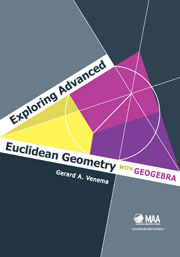Book contents
- Frontmatter
- Preface
- Contents
- 0 A Quick Review of Elementary Euclidean Geometry
- 1 The Elements of GeoGebra
- 2 The Classical Triangle Centers
- 3 Advanced Techniques in GeoGebra
- 4 Circumscribed, Inscribed, and Escribed Circles
- 5 The Medial and Orthic Triangles
- 6 Quadrilaterals
- 7 The Nine-Point Circle
- 8 Ceva's Theorem
- 9 The Theorem of Menelaus
- 10 Circles and Lines
- 11 Applications of the Theorem of Menelaus
- 12 Additional Topics in Triangle Geometry
- 13 Inversions in Circles
- 14 The Poincaré Disk
- References
- Index
- About the Author
Preface
- Frontmatter
- Preface
- Contents
- 0 A Quick Review of Elementary Euclidean Geometry
- 1 The Elements of GeoGebra
- 2 The Classical Triangle Centers
- 3 Advanced Techniques in GeoGebra
- 4 Circumscribed, Inscribed, and Escribed Circles
- 5 The Medial and Orthic Triangles
- 6 Quadrilaterals
- 7 The Nine-Point Circle
- 8 Ceva's Theorem
- 9 The Theorem of Menelaus
- 10 Circles and Lines
- 11 Applications of the Theorem of Menelaus
- 12 Additional Topics in Triangle Geometry
- 13 Inversions in Circles
- 14 The Poincaré Disk
- References
- Index
- About the Author
Summary
This book provides an inquiry-based introduction to advanced Euclidean geometry. It can be used either as a computer laboratory manual to supplement a course in the foundations of geometry or as a stand-alone introduction to advanced topics in Euclidean geometry. The geometric content is substantially the same as that of the first half of the classic text Geometry Revisited by Coxeter and Greitzer [3]; the organization and method of study, however, are quite different. The book utilizes dynamic geometry software, specifically GeoGebra, to explore the statements and proofs of many of the most interesting theorems in advanced Euclidean geometry. The text consists almost entirely of exercises that guide students as they discover the mathematics and then come to understand it for themselves.
Geometric content
The geometry studied in this book is Euclidean geometry. Euclidean geometry is named for Euclid of Alexandria, who lived from approximately 325 BC until about 265 BC. The ancient Greeks developed geometry to a remarkably advanced level and Euclid did his work during the later stages of that development. He wrote a series of books, called the Elements, that organize and summarize the geometry of ancient Greece. Euclid's Elements became by far the best known geometry text in history and Euclid's name is universally associated with geometry as a result.
- Type
- Chapter
- Information
- Exploring Advanced Euclidean Geometry with GeoGebra , pp. vii - xiiPublisher: Mathematical Association of AmericaPrint publication year: 2013

